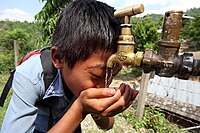
Photo from wikipedia
Hosting over 10% of the world's population, low elevation ( Click to show full abstract
Hosting over 10% of the world's population, low elevation (<10m above mean sea-level) coastal zones are susceptible to saline groundwater intrusion - making fresh groundwater an often scarce and threatened commodity. To inform suitable coastal groundwater management strategies, regional-scale mapping of fresh and salt groundwater occurrence is extremely beneficial. This mapping is usually based on conventional ground-based methods. However, these are not only slow and expensive, but result in localized and disconnected information which is uneconomical and impractical on the large scales required. Airborne electromagnetic (AEM) surveys have been proven a frugal and rapid way to overcome these shortcomings. Consequently, AEM methods are increasingly being used globally. Little is known about the effects of flightline spacing and additional ground-based data on the quality of mapping results, and in general the accuracy of AEM, other than validation against often sparse ground measurements. Understanding this is therefore invaluable as input to groundwater management strategies, survey planning and decision making. Here, we use a regional scale (900km2), high-resolution (50m x 50m x 0.5m) 3D synthetic model of electrical conductivity and geological properties, to investigate the effects of data availability on the accuracy of regional-scale groundwater salinity mapping. This was undertaken by simulating commonly used AEM parameters and realistic data acquisition methods. Two key data components are considered: (1) the AEM survey itself, and (2) geological information used to convert the AEM results into groundwater salinity. Spatially, different data-densities of these two components are quantitatively compared to highlight ideal geometrical configurations for given accuracy requirements. Our results indicate that in terms of optimising costs versus benefits, the value of additional lithological information is dependent on how well the initial distribution of electrical conductivity is resolved by the acquisition and inversion process.
Journal Title: Environmental Research Letters
Year Published: 2020
Link to full text (if available)
Share on Social Media: Sign Up to like & get
recommendations!